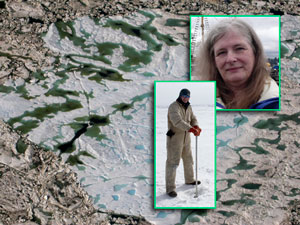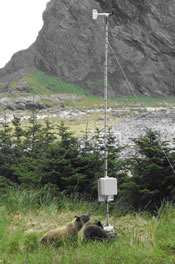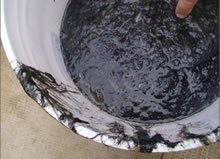 COSEE NOW podcast focuses on sea ice
COSEE NOW podcast focuses on sea ice
Sea ice shapes the physics, biology, and human activities in the Bering Sea between Alaska and Russia. The latest podcast from COSEE NOW features the work of scientists Hajo Eicken, Phyllis Stabeno, and Tom Weingartner. Sea ice photo: Hajo Eicken
Melting ice sends walrus to shore
(September 2010) A National Geographic video shows thousands of walruses gathered together in a dangerous “haul out” on the coast of Alaska earlier this month.
Scientists say the walruses came ashore in such large numbers because their normal habitats, Arctic ice floes, are melting.
New energy device to power oceanographic equipment
(June 2010) After two years of design and development, oceanographers at the University of Alaska Fairbanks are installing a new energy device along the Arctic coast of Alaska.
Right: The new device. (photo courtesy SeaDiscovery)
The device will use a combination of wind, solar, and biodiesel energy to power scientific instruments in remote areas, where sources of electricity are often scarce. “In principle, the device means that we can deploy the radar systems anywhere along Alaska’s coast,” said Tom Weingartner, professor of physical oceanography and the principal investigator for the project.
The device will power high-frequency radars that map sea surface currents along the coast of the Beaufort Sea, and is also equipped to collect meteorological and oceanographic data and houses communications equipment that allows researchers in Fairbanks to configure the device via satellite.
Find more information about this device at SeaDiscovery, a website devoted disseminating information on ocean science.
Spotlight on Orcas
(July 2009) Prince William Sound is home to approximately 30-200 “resident” fish eating killer whales, and seven “transient” marine mammal eating whales (with occasional transients visiting from the Gulf of Alaska). There are also more than 600 killer whales in the Gulf of Alaska that can be seen in or near the Sound. Right: Orca in Prince William Sound. (Craig Matkin)
Orcas are considered a sentinel species, and their health reflects the health of an ecosystem. Craig Matkin and Eva Saulitis of the North Gulf Oceanic Society have studied the orcas of the Sound since the mids1980s. The population of transient whales ( the AT1 pod) in the Sound has decreased by two thirds since 1989.
What do orcas sound like? Eva Saulitis knows; she did her Master’s thesis at the University of Alaska Fairbanks on the vocalizations and foraging behavior of the AT1 transient whales of Prince William Sound.
- Hear transient whales from the AT1 pod in Prince William Sound, recorded by Eva Saulitis
- Listen to resident whales from the AB pod in Prince William Sound, recorded by Eva Saulitis
New weather station at Cape St. Elias
(July 2009) Coordinated efforts between the Prince William Sound Science Center, the Prince William Sound RCAC, and the US Coast Guard resulted in the installation of a new weather station at Cape St. Elias, located southeast of Prince William Sound on Kayak Island.
Mysterious blob off Arctic coast has researchers wondering
“Something big and strange is floating through the Chukchi Sea between Wainwright and Barrow …” (Anchorage Daily News)
(July 2009) A smelly blob of material has formed off the Arctic coast in recent days, causing more than a little consternation on the part of area residents and scientists alike. The mass is thought to be biological in origin, possibly a decaying Phaeocystis algal bloom mixed with diatoms.
Other media links
- Anchorage Daily News | Huge blob of Arctic goo floats past Slope communities (July 14)
- Fairbanks Daily News-Miner | Tests show Alaska’s mysterious gooey blob is algae (July 16)
Harbor observation station launched in Seward
Seward City News, July 2009 | AOOS funding has made possible what scientists hope will be a statewide network of stations that collect data on atmospheric and ocean conditions near Alaska’s harbors.
The equipment is being installed on the breakwater crest at Seward’s harbor entrance. When completed, 2-minute averages of wind speed and direction, air temperature, barometric pressure, humidity, and solar radiation will be reported to displays in the Seward Harbormaster’s Office, on the data section of the AOOS website. Underwater sensors will measure water temperature and conductivity every second, with hourly averages used to compute and report water salinity and density. Tide level will be reported every six minutes and wave conditions every hour. Read full story
Active volcano threatens: UAF team responds
(April 2009) It took just a week of long days for a team from the University of Alaska Fairbanks School of Fisheries and Ocean Sciences to assemble funding and equipment to place High Frequency radar stations close to Mt. Redoubt in Cook Inlet, an active volcano threatening an oil storage facility. The radar stations were active for several weeks, providing real-time surface current data to be used in oil spill trajectory models in the event of an oil spill. Funding was provided by UAF, the Cook Inlet Regional Citizens Advisory Council and Alaska Sea Grant Program.
- See the demonstration of the NOAA HF Radar National Server and Architecture Project.
- Learn more about HF radar and surface currents and the work being done at the National Data Buoy Center.





